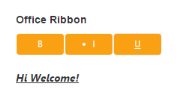Getting Started with ASP.NET MVC Button
13 Jun 202311 minutes to read
This section explains you briefly on how to create a Button in your application with ASP.NET MVC.
Create your first Button in MVC
Essential ASP.NET MVC Button provides support to display a Button control within your web page and allows you to Click, Toggle Click, Reset, and Submit. Using the following guidelines, you can customize Button for a real-time Multimedia player scenario. This allows you to Play, Pause, Stop, Mute, Un-mute a music player.
The following screenshot illustrates the functionality of Button in Multimedia player control.

Multimedia Player
Create Button Control in MVC
Essential ASP.NET MVC Button control contains built-in features like Click and different display option. You can easily create the Button control by using HTML helper as follows.
- You can create an MVC Project and add necessary assemblies, styles and scripts to it. Refer MVC-Getting Started.
- Add the following code example to the corresponding view page to render Button.
<table>
<tr>
<td>
@Html.EJ().ToggleButton("playPause").Size(ButtonSize.Large).ShowRoundedCorner(true)
.ContentType(ContentType.TextAndImage).ToggleState(true).DefaultPrefixIcon("e-icon e-mediaplay")
.ActivePrefixIcon("e-icon e-mediapause").DefaultText("Play").ActiveText("Pause")
</td>
<td> @Html.EJ().Button("mute").Size(ButtonSize.Large).ShowRoundedCorner(true).Text("Mute")
</td>
<td> @Html.EJ().Button("unmute").Size(ButtonSize.Large).ShowRoundedCorner(true).Text("unmute")
</td>
<td> @Html.EJ().Button("stop").Size(ButtonSize.Large).ShowRoundedCorner(true).Text("top")
</td>
</tr>
</table>Create Multimedia Player
-
Add the Action Result for Audio control in HomeController.cs file.
public ActionResult MyAudio() { var file = Server.MapPath("../song.mp3"); return File(file, "audio/mp3"); } -
Add the following code example to your view page to display Audio control and render the Button.
<div class="audiodiv"> <audio controls> <source src="@Url.Action("MyAudio","Home")" type="audio/mp3" /> <p>Your browser does not support HTML 5 audio element</p> </audio> </div> <div> <table> <tr> <td> @Html.EJ().ToggleButton("playPause").Size(ButtonSize.Large).ShowRoundedCorner(true) .ContentType(ContentType.TextAndImage).ToggleState(true).ClientSideEvents(e => e.Create("play").Click("pause") .Change("play")).DefaultPrefixIcon("e-icon e-mediaplay").ActivePrefixIcon("e-icon e-mediapause").DefaultText("Play").ActiveText("Pause") </td> <td> @Html.EJ().Button("mute").Size(ButtonSize.Large).ShowRoundedCorner(true).ClientSideEvents(e => e.Click("mute")).Text("Mute") </td> <td> @Html.EJ().Button("unmute").Size(ButtonSize.Large).ShowRoundedCorner(true).ClientSideEvents(e => e.Click("unmute")).Text("unmute") </td> <td> @Html.EJ().Button("stop").Size(ButtonSize.Large).ShowRoundedCorner(true).ClientSideEvents(e => e.Click("stop")).Text("stop") </td> </tr> </table> </div> -
Add the following event function to script section in your view page to use Button control feature as the Multimedia player control.
<script type="text/javascript"> //getting audio control access and stored in variable v var v = document.getElementsByTagName("audio")[0]; //trigger the audio control using variable v function play(e) { if (e.isChecked) { v.play(); } else { v.pause(); } } function start() { v.play(); } function stop() { v.pause(); } function mute() { v.volume = 0; } function unmute() { v.volume = 1; } </script> -
The following screenshot displays Multimedia player control.

Multimedia Player Control
Create Office Ribbon
In this section, you can learn how to create a Microsoft Office Ribbon used to change the style of the selected text. You can achieve this by using ASP.NET MVC Toggle Button control. You can change the styles by toggling the Button. Add the following code example to your view page to display OfficeRibbon control and render the Button.
<table>
<tr>
<td>
@Html.EJ().ToggleButton("Bold").Size(ButtonSize.Mini).ShowRoundedCorner(true).DefaultText("<b>B</b>").ActiveText("B").ClientSideEvents(e => e.Click("bold"))
</td>
<td>
@Html.EJ().ToggleButton("italic").Size(ButtonSize.Mini).ShowRoundedCorner(true).DefaultText("I").ActiveText("<li>I</li>").ClientSideEvents(e => e.Click("italic"))
</td>
<td>
@Html.EJ().ToggleButton("underline").Size(ButtonSize.Mini).ShowRoundedCorner(true).DefaultText("U").ActiveText("<u>U</u>").ClientSideEvents(e => e.Click("underline"))
</td>
</tr>
</table>-
Add the following code example in your view page for sample text.
<div class="sample"> <span id="sampletext">Hi Welcome!</span> </div> -
Add the following event function to the script section in your view page to use Button control feature as the Multimedia player control.
<script type="text/javascript"> function bold(e) { if (e.isChecked) { $(".sample span").wrap("<b></b>"); } else { $(".sample span").unwrap("<b></b>"); } } function italic(e) { if (e.isChecked) { $(".sample span").wrap("<i></i>"); } else { $(".sample span").unwrap("<i></i>"); } } function underline(e) { if (e.isChecked) { $(".sample span").wrap("<u></u>"); } else { $(".sample span").unwrap("<u></u>"); } } </script> -
The following screenshots display Office Ribbon control.

Office Ribbon before applying the styles

Office Ribbon after applying the styles